83 Results

By the end of this section, you will be able to:Explain the basic principles of the theory of evolution by natural selectionDescribe the differences between genotype and phenotypeDiscuss how gene-environment interactions are critical for expression of physical and psychological characteristics
- Subject:
- Psychology
- Social Science
- Material Type:
- Module
- Author:
- OpenStax College
- Date Added:
- 07/18/2021
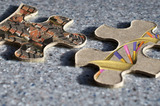
- Subject:
- Psychology
- Social Science
- Material Type:
- Module
- Author:
- OpenStax College
- Date Added:
- 07/18/2021
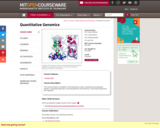
Subject assesses the relationships between sequence, structure, and function in complex biological networks as well as progress in realistic modeling of quantitative, comprehensive functional-genomics analyses. Topics include: algorithmic, statistical, database, and simulation approaches; and practical applications to biotechnology, drug discovery, and genetic engineering. Future opportunities and current limitations critically assessed. Problem sets and project emphasize creative, hands-on analyses using these concepts.
- Subject:
- Biology
- Genetics
- Life Science
- Material Type:
- Full Course
- Provider:
- M.I.T.
- Provider Set:
- M.I.T. OpenCourseWare
- Author:
- Berwick, Robert
- Kho, Alvin
- Kohane, Isaac
- Mirny, Leonid
- Date Added:
- 01/01/2005

Students create and decode DNA for mans best friend to observe how variations in DNA lead to the inheritance of different traits. Strips of paper that represent DNA are randomly selected and used to assemble the dog's DNA. Students read the DNA and create a drawing of their pet, and compare it with others in the class to check for similarities and differences.
- Subject:
- Biology
- Genetics
- Life Science
- Material Type:
- Activity/Lab
- Provider:
- National Science Teachers Association (NSTA)
- Provider Set:
- NGSS@NSTA
- Date Added:
- 07/07/2021
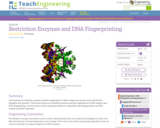
The discovery of restriction enzymes and their applications in DNA analysis has proven to be essential for biologists and chemists. This lesson focuses on restriction enzymes and their applications to DNA analysis and DNA fingerprinting. Use this lesson and its associated activity in conjunction with biology lessons on DNA analysis and DNA replication.
- Subject:
- Applied Science
- Engineering
- Genetics
- Life Science
- Physical Science
- Physics
- Material Type:
- Lesson Plan
- Provider:
- TeachEngineering
- Provider Set:
- TeachEngineering
- Author:
- Mircea Ionescu
- Myla Van Duyn
- Date Added:
- 09/18/2014
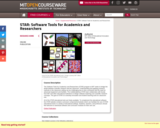
The Software Tools for Academics and Researchers (STAR) program at MIT seeks to bridge the divide between scientific research and the classroom. Understanding and applying research methods in the classroom setting can be challenging due to time constraints and the need for advanced equipment and facilities. The multidisciplinary STAR team collaborates with faculty from MIT and other educational institutions to design software exploring core scientific research concepts. The goal of STAR is to develop innovative and intuitive teaching tools for classroom use. All of the STAR educational tools are freely available. To complement the educational software, the STAR website contains curriculum components/modules which can facilitate the use of STAR educational tools in a variety of educational settings. Students, teachers, and professors should feel welcome to download software and curriculum modules for their own use. Online Publication
- Subject:
- Applied Science
- Information Science
- Material Type:
- Full Course
- Provider:
- M.I.T.
- Provider Set:
- M.I.T. OpenCourseWare
- Date Added:
- 01/01/2012

Statistical Physics in Biology is a survey of problems at the interface of statistical physics and modern biology. Topics include: bioinformatic methods for extracting information content of DNA; gene finding, sequence comparison, and phylogenetic trees; physical interactions responsible for structure of biopolymers; DNA double helix, secondary structure of RNA, and elements of protein folding; considerations of force, motion, and packaging; protein motors, membranes. We also look at collective behavior of biological elements, cellular networks, neural networks, and evolution.
- Subject:
- Biology
- Life Science
- Physical Science
- Physics
- Material Type:
- Full Course
- Provider:
- M.I.T.
- Provider Set:
- M.I.T. OpenCourseWare
- Author:
- Kardar, Mehran
- Leonid Mirny
- Date Added:
- 01/01/2005

Explore stretching just a single strand of DNA using optical tweezers or fluid flow. Experiment with the forces involved and measure the relationship between the stretched DNA length and the force required to keep it stretched. Is DNA more like a rope or like a spring?
- Subject:
- Genetics
- Life Science
- Material Type:
- Simulation
- Provider:
- University of Colorado Boulder
- Provider Set:
- PhET Interactive Simulations
- Author:
- Chris Malley
- Kathy Perkins
- Meredith Betterton
- Mike Dubson
- Tom Perkins
- Wendy Adams
- Date Added:
- 12/01/2007

Explore stretching just a single strand of DNA using optical tweezers or fluid flow. Experiment with the forces involved and measure the relationship between the stretched DNA length and the force required to keep it stretched. Is DNA more like a rope or like a spring?
- Subject:
- Genetics
- Life Science
- Material Type:
- Simulation
- Provider:
- University of Colorado Boulder
- Provider Set:
- PhET Interactive Simulations
- Author:
- Chris Malley
- Kathy Perkins
- Meredith Betterton
- Michael Dubson
- Thomas Perkins
- Wendy Adams
- Date Added:
- 12/01/2007

How is it that all cells in our body have the same genes, yet cells in different tissues express different genes? A basic notion in biology that most high school students fail to conceptualize is the fact that all cells in the animal or human body contain the same DNA, yet different cells in different tissues express, on the one hand, a set of common genes, and on the other, express another set of genes that vary depending on the type of tissue and the stage of development. In this video lesson, the student will be reminded that genes in a cell/tissue are expressed when certain conditions in the nucleus are met. Interestingly, the system utilized by the cell to ensure tissue specific gene expression is rather simple. Among other factors - all discussed fully in the lesson - the cells make use of a tiny scaffold known as the “Nuclear Matrix or Nucleo-Skeleton”. This video lesson spans 20 minutes and provides 5 exercises for students to work out in groups and in consultation with their classroom teacher. The entire duration of the video demonstration and exercises should take about 45-50 minutes, or equivalent to one classroom session. There are no supplies needed for students’ participation in the provided exercises. They will only need their notebooks and pens. However, the teacher may wish to emulate the demonstrations used in the video lesson by the presenter and in this case simple material can be used as those used in the video. These include play dough, pencils, rubber bands (to construct the nuclear matrix model), a tennis ball and 2-3 Meters worth of shoe laces. The students should be aware of basic information about DNA folding in the nucleus, DNA replication, gene transcription, translation and protein synthesis.
- Subject:
- Biology
- Genetics
- Life Science
- Material Type:
- Lecture
- Provider:
- MIT
- Provider Set:
- MIT Blossoms
- Author:
- Rabih Talhouk, Elia El-Habre
- Date Added:
- 07/02/2021

it would be ideal if students already have learned that DNA is the genetic material, and that DNA is made up of As, Ts, Gs, and Cs. It also would help if students already know that each human has two versions of every piece of DNA in their genome, one from mom and one from dad. The lesson will take about one class period, with roughly 30 minutes of footage and 30 minutes of activities.
- Subject:
- Biology
- Career and Technical Education
- Criminal Justice
- Genetics
- Life Science
- Material Type:
- Lecture
- Provider:
- MIT
- Provider Set:
- MIT Blossoms
- Author:
- Megan E. Rokop
- Date Added:
- 07/02/2021

- Subject:
- Biology
- Material Type:
- Full Course
- Date Added:
- 09/29/2021

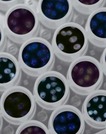
In this lesson, students will perform restriction digestion of lambda DNA.
- Material Type:
- Lesson
- Author:
- OER Librarian
- Date Added:
- 09/29/2021
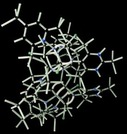
In this lesson, students will explain the similarities and differences between DNA and RNA structure, list the different types of RNA and describe their function, explain the central dogma of molecular biology, and explain the genetic code table.
- Material Type:
- Lesson
- Author:
- OER Librarian
- Date Added:
- 09/29/2021

In this lesson, students will design an experiment to separate DNA fragments by agarose gel electrophoresis under two different conditions either varying pH, voltage, or % agarose. They will calculate and prepare the necessary solutions required to perform the experiment.
- Material Type:
- Lesson
- Author:
- OER Librarian
- Date Added:
- 09/29/2021

In this lesson, students will perform agarose gel electrophoresis under two different conditions either different pH, voltage, or % agarose.
- Material Type:
- Lesson
- Author:
- OER Librarian
- Date Added:
- 09/29/2021

In this lesson, students will model pouring molten agarose and loading DNA samples into agarose gels, then separate DNA Fragments using agarose gel electrophoresis and explain how methylene blue stains DNA.
- Material Type:
- Lesson
- Author:
- OER Librarian
- Date Added:
- 09/29/2021
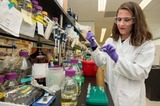
In this lesson, students will define restriction enzyme and explain how restriction enzymes work. Then they will model how restriction enzymes work using a game simulation and explain the use of restriction enzymes in DNA fingerprinting.
- Material Type:
- Lesson
- Author:
- OER Librarian
- Date Added:
- 09/29/2021
